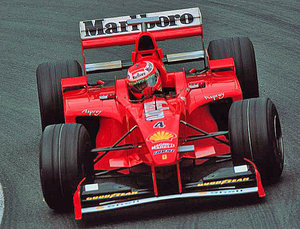Difference between revisions of "Ferrari F300"
Jump to navigation
Jump to search
m |
m |
||
| Line 67: | Line 67: | ||
The car was competitive and reliable but was aerodynamically inferior to the [[McLaren MP4/13]] and [[Michael Schumacher]] battled to second place in the world championship behind [[Mika Häkkinen]]. Ferrari finished as runners-up in the constructors' championship, but the car paved the way for the dominance Ferrari had in the following seasons. | The car was competitive and reliable but was aerodynamically inferior to the [[McLaren MP4/13]] and [[Michael Schumacher]] battled to second place in the world championship behind [[Mika Häkkinen]]. Ferrari finished as runners-up in the constructors' championship, but the car paved the way for the dominance Ferrari had in the following seasons. | ||
| + | |||
| + | [[Image:1998_ferrari_f300_4.jpg|thumb|left|300px]] | ||
| + | |||
{{-}} | {{-}} | ||
==Complete Formula One results== | ==Complete Formula One results== | ||
Revision as of 15:49, 26 February 2008
| thumb | |
| Category | Formula One |
|---|---|
| Constructor | Ferrari |
| Team/s | Ferrari |
| Designer | Rory Byrne |
| Drivers | 3. Michael Schumacher 4. Eddie Irvine |
| Chassis | carbon-fibre and honeycomb composite structure |
| Suspension (front) | double wishbones, pushrod |
| Suspension (rear) | double wishbones, pushrod |
| Engine | Ferrari 047/B/C 75-degree V10 |
| Gearbox | Ferrari seven-speed longitudinal semi-automatic sequential |
| Fuel | Shell |
| Tyres | Goodyear |
| Debut | 1998 Australian Grand Prix |
| Races competed | 16 |
| Constructors' Championships | 0 |
| Drivers' Championships | 0 |
| Race victories | 6 |
| Pole positions | 3 |
| Fastest laps | 6 |
The Ferrari F300 was a Formula One car designed by Rory Byrne for the 1998 Formula One Season. It was powered by a 3.0 V10 engine and designed around a narrower track as mandated by the FIA in a series of regulation changes for that season.
The car was competitive and reliable but was aerodynamically inferior to the McLaren MP4/13 and Michael Schumacher battled to second place in the world championship behind Mika Häkkinen. Ferrari finished as runners-up in the constructors' championship, but the car paved the way for the dominance Ferrari had in the following seasons.
Complete Formula One results
(key) (results in bold indicate pole position)
| Year | Team | Engine | Tyres | Drivers | 1 | 2 | 3 | 4 | 5 | 6 | 7 | 8 | 9 | 10 | 11 | 12 | 13 | 14 | 15 | 16 | Points | WCC |
|---|---|---|---|---|---|---|---|---|---|---|---|---|---|---|---|---|---|---|---|---|---|---|
| 1998 | Ferrari | Ferrari 047 V10 | G | AUS | BRA | ARG | SMR | ESP | MON | CAN | FRA | GBR | AUT | DEU | HUN | BEL | ITA | LUX | JPN | 133 | 2nd | |
| Michael Schumacher | Ret | 3 | 1 | 2 | 3 | 10 | 1 | 1 | 1 | 3 | 5 | 1 | Ret | 1 | 2 | Ret | ||||||
| Eddie Irvine | 4 | 8 | 3 | 3 | Ret | 3 | 3 | 2 | 3 | 4 | 8 | Ret | Ret | 2 | 4 | 2 |
| Ferrari Formula One cars | |||||||||||||||||||||||||||||||||||||||||
| 40s | 1950s | 1960s | 1970s | ||||||||||||||||||||||||||||||||||||||
| 8 | 9 | 0 | 1 | 2 | 3 | 4 | 5 | 6 | 7 | 8 | 9 | 0 | 1 | 2 | 3 | 4 | 5 | 6 | 7 | 8 | 9 | 0 | 1 | 2 | 3 | 4 | 5 | 6 | 7 | 8 | 9 | ||||||||||
| 125 | 275 340 375 |
500 | 553 625 |
555 D50 |
801 | 412 246 |
256 | 156 | 158 1512 |
312 | 312 B | 312 T | |||||||||||||||||||||||||||||
| 1980s | 1990s | 2000s | |||||||||||||||||||||||||||||||||||||||
| 0 | 1 | 2 | 3 | 4 | 5 | 6 | 7 | 8 | 9 | 0 | 1 | 2 | 3 | 4 | 5 | 6 | 7 | 8 | 9 | 0 | 1 | 2 | 3 | 4 | 5 | 6 | 7 | 8 | 9 | ||||||||||||
| 312 T | 126 C | 156/85 | F1/86 | F1/87 | 640 | 641 | 642/643 | F92A | F93A | 412T | F310/B | F300 | F399 | F1-2000 | F2001 | F2001 F2002 |
F2002B F2003-GA |
F2004 | F2004M F2005 |
248 | F2007 | ||||||||||||||||||||
